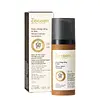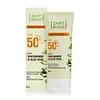What's inside
What's inside
 Key Ingredients
Key Ingredients

 Benefits
Benefits

 Concerns
Concerns

 Ingredients Side-by-side
Ingredients Side-by-side

Water
Skin ConditioningC12-15 Alkyl Benzoate
AntimicrobialIsododecane
EmollientCyclopentasiloxane
EmollientBis-Ethylhexyloxyphenol Methoxyphenyl Triazine
Skin ConditioningButyloctyl Salicylate
Skin ConditioningTris-Biphenyl Triazine
UV AbsorberSilica
AbrasiveMethyl Methacrylate Crosspolymer
Dicaprylyl Carbonate
EmollientEthylhexyl Triazone
UV AbsorberButyl Methoxydibenzoylmethane
UV AbsorberDiethylamino Hydroxybenzoyl Hexyl Benzoate
UV FilterEthylhexyl Methoxycrylene
Skin ConditioningCaprylyl Methicone
Skin ConditioningBenincasa Cerifera Fruit Extract
Skin ConditioningNiacinamide
SmoothingBetaine
HumectantHydroxymethoxyphenyl Decanone
Skin ConditioningTetrahexyldecyl Ascorbate
AntioxidantGlycine Soja Seed Extract
Skin ConditioningAcrylates/C10-30 Alkyl Acrylate Crosspolymer
Emulsion StabilisingTrimethylsiloxysilicate
EmollientGlycerin
HumectantPropanediol
SolventButylene Glycol
HumectantPentylene Glycol
Skin Conditioning1,2-Hexanediol
Skin ConditioningTrisodium Ethylenediamine Disuccinate
Tocopherol
AntioxidantDecyl Glucoside
CleansingEthylhexylglycerin
Skin ConditioningCaprylic/Capric Triglyceride
MaskingDisodium Phosphate
BufferingXanthan Gum
EmulsifyingPhenoxyethanol
PreservativeWater, C12-15 Alkyl Benzoate, Isododecane, Cyclopentasiloxane, Bis-Ethylhexyloxyphenol Methoxyphenyl Triazine, Butyloctyl Salicylate, Tris-Biphenyl Triazine, Silica, Methyl Methacrylate Crosspolymer, Dicaprylyl Carbonate, Ethylhexyl Triazone, Butyl Methoxydibenzoylmethane, Diethylamino Hydroxybenzoyl Hexyl Benzoate, Ethylhexyl Methoxycrylene, Caprylyl Methicone, Benincasa Cerifera Fruit Extract, Niacinamide, Betaine, Hydroxymethoxyphenyl Decanone, Tetrahexyldecyl Ascorbate, Glycine Soja Seed Extract, Acrylates/C10-30 Alkyl Acrylate Crosspolymer, Trimethylsiloxysilicate, Glycerin, Propanediol, Butylene Glycol, Pentylene Glycol, 1,2-Hexanediol, Trisodium Ethylenediamine Disuccinate, Tocopherol, Decyl Glucoside, Ethylhexylglycerin, Caprylic/Capric Triglyceride, Disodium Phosphate, Xanthan Gum, Phenoxyethanol
Water
Skin ConditioningPhenylbenzimidazole Sulfonic Acid
UV AbsorberGlycerin
HumectantEthylhexyl Methoxycinnamate
UV AbsorberDisodium Phenyl Dibenzimidazole Tetrasulfonate
UV AbsorberCyclopentasiloxane
EmollientDimethicone Crosspolymer
Emulsion StabilisingCarbomer
Emulsion StabilisingSodium Hydroxide
BufferingDimethicone
EmollientNiacinamide
SmoothingAloe Barbadensis Leaf Juice
Skin ConditioningPhenoxyethanol
PreservativeEthylhexylglycerin
Skin ConditioningXanthan Gum
EmulsifyingParfum
MaskingSilica
AbrasiveTocopheryl Acetate
AntioxidantAllantoin
Skin ConditioningMenthol
MaskingDisodium EDTA
Sodium Ascorbyl Phosphate
AntioxidantWater, Phenylbenzimidazole Sulfonic Acid, Glycerin, Ethylhexyl Methoxycinnamate, Disodium Phenyl Dibenzimidazole Tetrasulfonate, Cyclopentasiloxane, Dimethicone Crosspolymer, Carbomer, Sodium Hydroxide, Dimethicone, Niacinamide, Aloe Barbadensis Leaf Juice, Phenoxyethanol, Ethylhexylglycerin, Xanthan Gum, Parfum, Silica, Tocopheryl Acetate, Allantoin, Menthol, Disodium EDTA, Sodium Ascorbyl Phosphate
 Reviews
Reviews

Ingredients Explained
These ingredients are found in both products.
Ingredients higher up in an ingredient list are typically present in a larger amount.
Cyclopentasiloxane, or D5, is a silicone used to improve texture of products and trap moisture.
D5 is considered lightweight and volatile. Volatile means it evaporates quickly after application. Once evaporated, D5 leaves a thin barrier that helps keep skin hydrated.
It is also an emollient. Emollients help soften the skin and prevent water loss. Silicones create a silky texture in products. D5 helps other ingredients become more spreadable.
Studies show D5 is safe to use in skincare products. We recommend speaking with a skincare professional if you have concerns.
Learn more about CyclopentasiloxaneEthylhexylglycerin (we can't pronounce this either) is commonly used as a preservative and skin softener. It is derived from glyceryl.
You might see Ethylhexylglycerin often paired with other preservatives such as phenoxyethanol. Ethylhexylglycerin has been found to increase the effectiveness of these other preservatives.
Glycerin is already naturally found in your skin. It helps moisturize and protect your skin.
A study from 2016 found glycerin to be more effective as a humectant than AHAs and hyaluronic acid.
As a humectant, it helps the skin stay hydrated by pulling moisture to your skin. The low molecular weight of glycerin allows it to pull moisture into the deeper layers of your skin.
Hydrated skin improves your skin barrier; Your skin barrier helps protect against irritants and bacteria.
Glycerin has also been found to have antimicrobial and antiviral properties. Due to these properties, glycerin is often used in wound and burn treatments.
In cosmetics, glycerin is usually derived from plants such as soybean or palm. However, it can also be sourced from animals, such as tallow or animal fat.
This ingredient is organic, colorless, odorless, and non-toxic.
Glycerin is the name for this ingredient in American English. British English uses Glycerol/Glycerine.
Learn more about GlycerinNiacinamide is a multitasking form of vitamin B3 that strengthens the skin barrier, reduces pores and dark spots, regulates oil, and improves signs of aging.
And the best part? It's gentle and well-tolerated by most skin types, including sensitive and reactive skin.
You might have heard of "niacin flush", or the reddening of skin that causes itchiness. Niacinamide has not been found to cause this.
In very rare cases, some individuals may not be able to tolerate niacinamide at all or experience an allergic reaction to it.
If you are experiencing flaking, irritation, and dryness with this ingredient, be sure to double check all your products as this ingredient can be found in all categories of skincare.
When incorporating niacinamide into your routine, look out for concentration amounts. Typically, 5% niacinamide provides benefits such as fading dark spots. However, if you have sensitive skin, it is better to begin with a smaller concentration.
When you apply niacinamide to your skin, your body converts it into nicotinamide adenine dinucleotide (NAD). NAD is an essential coenzyme that is already found in your cells as "fuel" and powers countless biological processes.
In your skin, NAD helps repair cell damage, produce new healthy cells, support collagen production, strengthen the skin barrier, and fight environmental stressors (like UV and pollution).
Our natural NAD levels start to decline with age, leading to slower skin repair, visible aging, and a weaker skin barrier. By providing your skin niacinamide, you're recharging your skin's NAD levels. This leads to stronger, healthier, and younger looking skin.
Another name for vitamin B3 is nicotinamide. This vitamin is water-soluble and our bodies don't store it. We obtain Vitamin B3 from either food or skincare. Meat, fish, wheat, yeast, and leafy greens contain vitamin B3.
The type of niacinamide used in skincare is synthetically created.
Learn more about NiacinamidePhenoxyethanol is a preservative that has germicide, antimicrobial, and aromatic properties. Studies show that phenoxyethanol can prevent microbial growth. By itself, it has a scent that is similar to that of a rose.
It's often used in formulations along with Caprylyl Glycol to preserve the shelf life of products.
Silica, also known as silicon dioxide, is a naturally occurring mineral. It is used as a fine, spherical, and porous powder in cosmetics.
Though it has exfoliant properties, the function of silica varies depending on the product.
The unique structure of silica enhances the spreadability and adds smoothness, making it a great texture enhancer.
It is also used as an active carrier, emulsifier, and mattifier due to its ability to absorb excess oil.
In some products, tiny microneedles called spicules are made from silica or hydrolyzed sponge. When you rub them in, they lightly polish away dead skin layers and enhance the penetration of active ingredients.
Learn more about SilicaWater. It's the most common cosmetic ingredient of all. You'll usually see it at the top of ingredient lists, meaning that it makes up the largest part of the product.
So why is it so popular? Water most often acts as a solvent - this means that it helps dissolve other ingredients into the formulation.
You'll also recognize water as that liquid we all need to stay alive. If you see this, drink a glass of water. Stay hydrated!
Learn more about WaterXanthan gum is used as a stabilizer and thickener within cosmetic products. It helps give products a sticky, thick feeling - preventing them from being too runny.
On the technical side of things, xanthan gum is a polysaccharide - a combination consisting of multiple sugar molecules bonded together.
Xanthan gum is a pretty common and great ingredient. It is a natural, non-toxic, non-irritating ingredient that is also commonly used in food products.
Learn more about Xanthan Gum